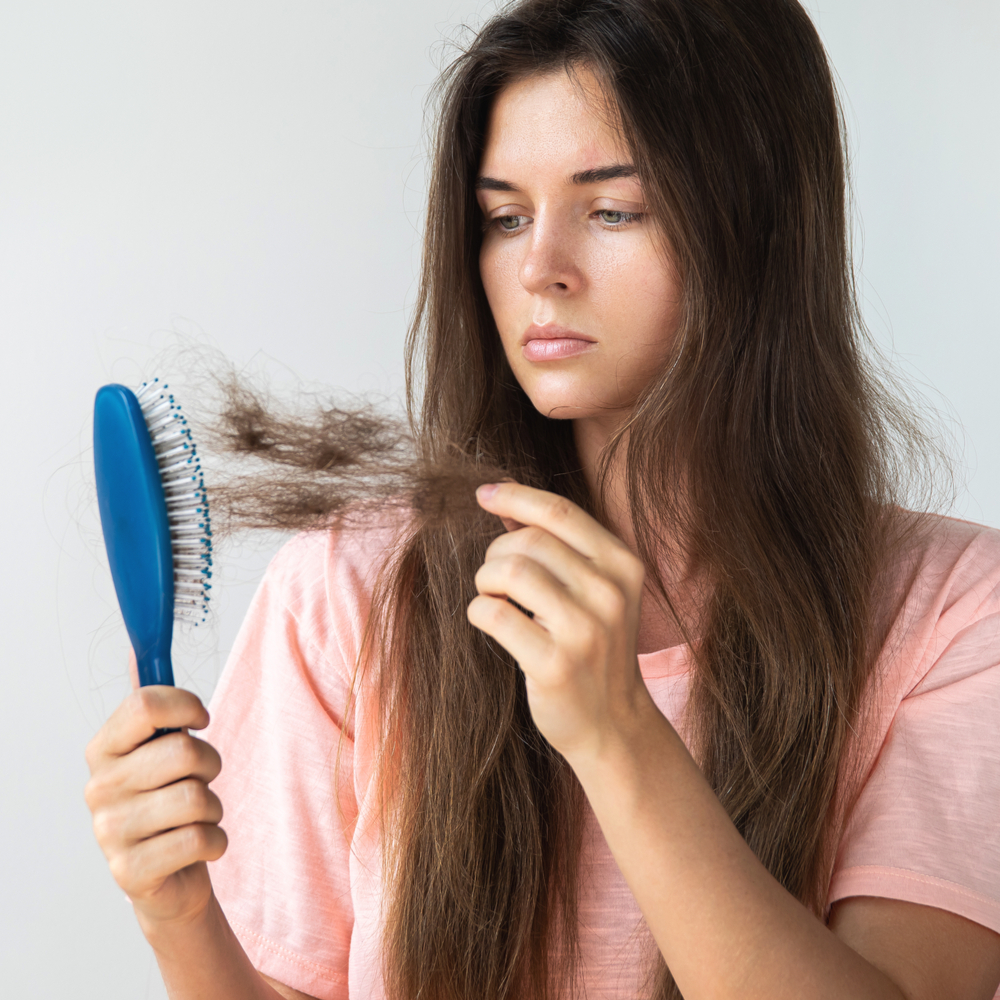alopécia por estresse ou psicogênica
A alopécia psicogênica é um tipo de alopécia relacionada ao estresse: essa conexão, embora ainda não tenha sido explicada cientificamente, é bem conhecida na experiência de quem lida com o problema.

Scientific collaboration between Professor Marco Toscani and Dr. Pasquale Fino, Chair of Plastic, Reconstructive and Aesthetic Surgery, Umberto I Health Center – “Sapienza” University of Rome.
With the term Telogen Defluvium we mean a modest, not excessive, loss of hair in the telogen phase, but which tends to often be irreversible, with the precise characteristics of hair in decay or involution. The hair that falls out is usually short and fine, with bulbs that are undeveloped and reduced in size.
Telogen Defluvium is nothing other than Androgenetic Defluvium (pattern hair loss).
With Telogen Defluvium the number of hairs lost does not exceed 100. With the pull test only two or three hairs at most are usually obtained. This means that due to the defluvium, the anagen phase has become temporally shorter (compared to its usually length), thus reducing the ability of hair follicles to sustain hair growth.
An alteration of the trichogram is almost non-existent with a number of hair in the anagen phase at around 80% due to a temporal reduction of the anagen phase of the hair follicle.
Due to a very short anagen phase, between 10% and 60% of fallen hair are short, thin and with bulbs that have a very thin diameter. They are moreover located on the surface of the dermis compared to hair that has a normal growth cycle. This hair is in between terminal hair and vellus hair.
It is included among hair in the involution phase with a short anagen phase and therefore is considered like hair in the premature telogen phase which falls out before its time. It is short and thin because it does not have time to develop (short anagen phase), it appears small and involute after a very short anagen phase and is characteristic of this form of hair loss. The follicle remains histologically present for a long time, even if it is not as deep and contains a hair that is increasingly involute. Only very late does this hair go towards hyalinosis.
This is a pathological process that may manifest in various bodily structures, characterized by the intra- and extra-cellular accumulation of material, called hyaliane, which damages the structure and function of the affected areas, resulting in progressive atrophy. The hair loss resulting from this is similar to a scarring form with loss of the skin adnexa.
We can distinguish between an acute form of Telogen Defluvium (very intense and characterized by a temporary loss of hair) and a chronic form of Telogen Defluvium (a modest type with a constant loss of hair).
In men common causes of Telogen Defluvium are both pattern hair loss (chronic telogen defluvium) and male frontoparietal alopecia (chronic telogen defluvium).
Instead, in women common causes of Telogen Defluvium are more numerous. Among them we note: pattern hair loss from drugs (acute telogen defluvium), post-menopause hair loss (acute telogen defluvium), hair loss from androgen secreting tumors (acute telogen defluvium), hereditary hair loss (chronic telogen defluvium), polycystic ovary hair loss, congenital adrenal hyperplasia hair loss (acute telogen defluvium), hair loss from anorexia nervosa (acute telogen defluvium) and lastly hair loss from hyperprolactinemia (acute telogen defluvium).
A alopécia psicogênica é um tipo de alopécia relacionada ao estresse: essa conexão, embora ainda não tenha sido explicada cientificamente, é bem conhecida na experiência de quem lida com o problema.
Seborrheic hair loss is a form of premature hair loss that generally afflicts men in their youth (onset between 20 and 30 years of age), mainly affecting the frontal region and the crown. The cause, as the name of the condition suggests, is related to an excess production of sebum that provokes or accelerates hair loss.
Trichotillomania is a type of hair loss due to voluntary pulling by the patient which often ends up breaking the hair shaft. In general, the patient twists the hair around a finger.
The gesture is occasional when going to sleep or concentrating on a task, but may become repetitive or obsessive.
A alopécia androgenética é o tipo de alopécia mais comum, que atinge a maior parte da população masculina branca, por motivos diversos. É menos frequente em outros grupos étnicos. Muitas vezes apresenta uma familiaridade com a calvície, mas a ausência de outros parentes com a doenção não exclui o diagnóstico. É caracterizada por uma progressiva queda capilar na região do vértice, na marginal frontal anterior e na região temporal.
A hair follicle is a formation of epidermal origin, anchored in the dermis and consisting of a hair and its sheath.
The formation of hair follicles occurs early. They begin to appear as early as the second month of gestation. These follicles will continue to form for the entire duration of the pregnancy. At birth, the baby will indeed have the entire supply of follicles with which it was genetically equipped and from this moment on, no others will form.
Brittle hair is hair that appears opaque and without shininess. It is characterized by glaringly visible damage and deterioration of the shaft.
The causes that lead to the problem of brittle hair may be of endogenous and exogenous origin.
Nossos especialistas te ajudarão a encontrar o tratamento mais adequado às suas exigências.
Agende uma consulta com nossos especialistas e conheça todos os tratamentos CRLAB.
Nossos especialistas estão prontos para encontrar a solução ideal para você.
NOSSAS SOLUÇÕES CRLAB, especialistas no bem-estar dos cabelos e do couro cabeludo
O método mais eficaz no combate à calvície. Recupera os cabelos de modo espesso e natural, o que permite ao paciente recuperar a sua aparência original. Uma solução patenteada que integra cabelos virgens naturais nas regiões atingidas por falhas de fios e pela calvície: um sistema completamente personalizado que garante funcionalidade e
uma aparência natural.